- Welcome
- Health concerns
- Tiredness
- Vitamin D3 5000 IU
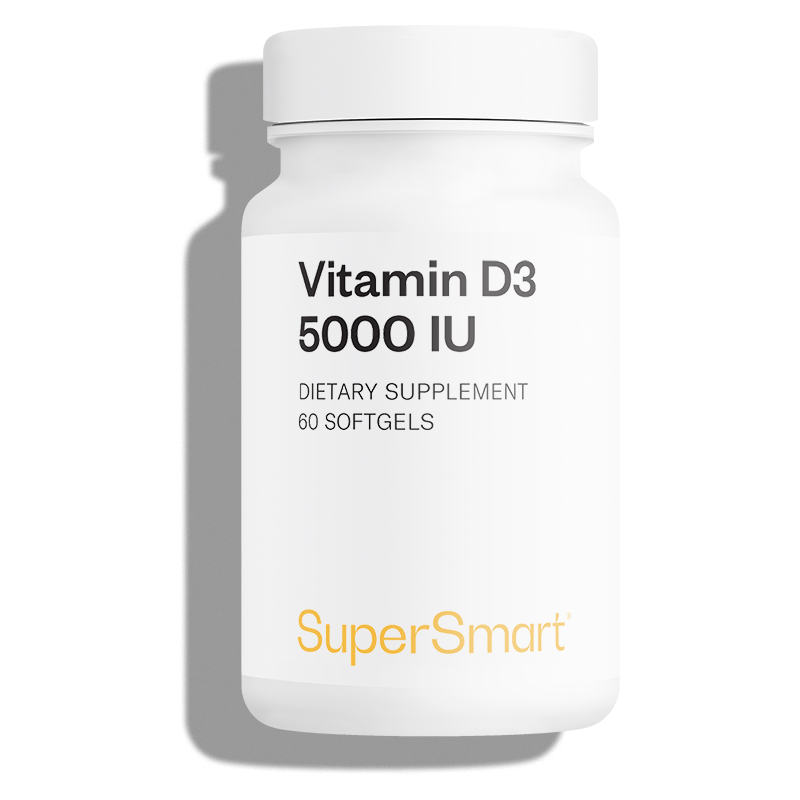
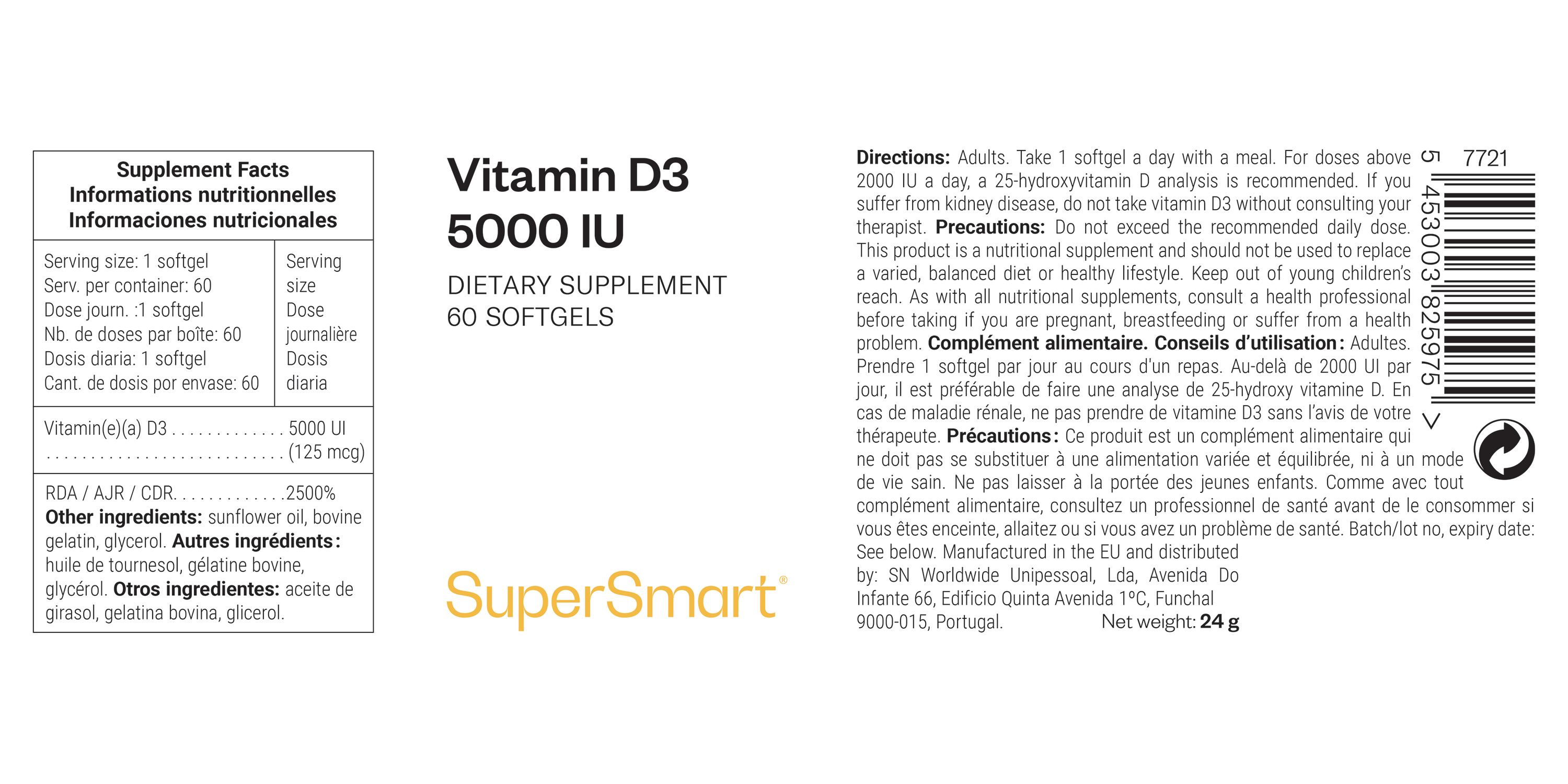
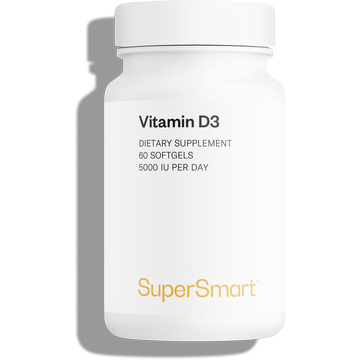


In stock
- A powerful, bioavailable form of vitamin D3 for optimal absorption
- Contributes to normal immune system function.
- Helps maintain normal bones, teeth and muscle function.
- Contributes to normal blood calcium levels.
- Plays a role in the cell division process.
- Packaged in oily capsules for maximum absorption.
- Dosage of 5000 IU per softgel.
Vitamin D3 5000 IU
Complete your selection
Vitamin D3 5000 IU is an exceptional supplement containing 5000IU of vitamin D3 (the most bioavailable form) per softgel. It is enriched with sunflower oil to maximise its absorption.
Daily or twice a week supplementation with Vitamin D3 5000 IU produces a rapid increase in circulating levels of the vitamin, as confirmed by blood tests, and has a positive effect on cardiovascular, endocrine, nervous system, immune and cognitive function.
Who is Vitamin D3 5000 IU aimed at?
The latest studies show that between the months of October and April, almost everyone (1-4) living at a high latitude has an inadequate level of vitamin D (5-6). March sees levels reach their lowest point (7-8).
Vitamin D3 5000 IU is thus aimed at anyone living in France, Italy, Germany, Spain, the Netherlands, Portugal, Poland, the UK, Canada and the United States throughout autumn and winter.
Vitamin D is produced by the body on exposure of the skin to the sun’s ultra-violet rays (UVB). However, in temperate regions of the Northern Hemisphere, the conditions are not conducive to this process, both because of the sun’s angle of elevation and the weather during these seasons, as well as urban lifestyles: at this time of year, we tend to stay indoors and cover ourselves up too much to maintain adequate vitamin D production. Peak production rapidly plummets from November onwards and reserves are quickly exhausted.
Vitamin D3 5000 IU can also be used in the spring and summer by many groups of people (40% of individuals have inadequate levels even during these periods):
- Those with dark skin who live at high or middle latitudes, because they need more sun than a fair-skinned person to produce the same amount of vitamin D.
- Those who are less mobile or who do not get much exposure to the sun.
- Those who are overweight, because vitamin D produced from the sun’s rays is sequestered by the fatty layers under the skin.
- Those over 50 (9), both due to less exposure to the sun (delicate skin) and less efficient conversion of vitamin D precursors into vitamin D in the superficial epithelial layers of the skin.
- Those suffering from bone disease.
- Those with malabsorption problems and inflammatory bowel disease because this makes absorbing fats more difficult.
- Those following specific diets (excluding meat, fish, eggs or products fortified with vitamin D).
- Those living in areas of high pollution, as CO2 absorbs UV rays.
- Those who regularly use UVB-blocking sunscreens (with an SPF above 15) as these can prevent up to 99% of UVB from penetrating the skin.
For all these groups of people, Vitamin D3 5000IU is often the safest way of quickly increasing their levels of vitamin D and of maintaining them throughout the year, now available to buy at Supersmart.
What are the effects of too little vitamin D?
Vitamin D is not really a vitamin: it should actually be thought of as a hormone. It performs many functions in the body, the best-known of which are its key roles in the intestinal absorption and binding to bones of dietary calcium, in muscle function, in maintaining cognitive function, in supporting the immune system and in tissue cell renewal.
The effects of a lack of vitamin D may go unnoticed for years but in the long term, they can be serious: softening of bones (osteomalacia), osteoporosis, bone pain, muscle weakness, joint pain (particularly in the wrists, ankles and shoulders), migraines, increased risk of depression, insomnia, hair loss (10) …
Conversely, optimal vitamin D levels bring numerous benefits for our health:
- Optimisation of bone health (11-13).
- Reduced risk of cardiovascular disease and stroke (at doses of at least 600IU a day (14)).
- A decrease in blood pressure (at doses of at least 2000IU a day (15)).
- Improved blood cholesterol levels (at doses of at least 2000IU a day (16)).
- Increased strength and muscular balance (at doses of at least 800- 1000 IU a day (17)).
- Reduced risk of neurocognitive problems and auto-immune diseases.
- Potential reduction in fibromyalgia pain (at doses of at least 2400 IU a day) (18).
| Daily dose : 1 softgel Number of doses per box : 60 |
Amount per dose |
| Vitamin D3 | 5000 IU |
| Other ingredients : sunflower oil | |
Warning : At doses above 2000 IU a day, a 25-hydroxyl vitamin D analysis should be carried out. If you suffer from kidney disease, do not take vitamin D3 without consulting your therapist. Do not exceed 10,000 IU a day, all sources combined, without the advice of your therapist.
- Ganji V, Zhang X, Tangpricha V. Serum 25-hydroxyvitamin D concentrations and prevalence estimates of hypovitaminosis D in the U.S. population based on assay-adjusted data. J Nutr 2012;142(3):498–507. doi: 10.3945/jn.111.151977
- Greene-Finestone LS, Berger C, de Groh M, Hanley DA, Hidiroglou N, Sarafin K et al. 25-Hydroxyvitamin D in Canadian adults: biological, environmental, and behavioral correlates. Osteoporos Int2011;22(5):1389–1399. doi: 10.1007/s00198-010-1362-7
- PÃ Âudowski P. Konstantynowicz J, Jaworski K. Assessment of vitamin D status in Polish adult population. Standardy Medyczne/Pediatria 2014;(11):609–617.
- Vierucci F, Del Pistoia M, Fanos M, Erba P, Saggese G. Prevalence of hypovitaminosis D and predictors of vitamin D status in Italian healthy adolescents. It J Pediatr 2014;40:54 doi: 10.1186/1824-7288-40-54
- Hyppoènen E, Power C. Hypovitaminosis D in British adults at age 45 y: nationwide cohort study of dietary and lifestyle predictors. Am J
- Darling AL, Hart KH, Macdonald HM, Horton K, KangâÂÂombe AR, Berry JL, Lanham-New SA. Vitamin D deficiency in UK South Asian women of childbearing age: a comparative longitudinal investigation with UK European women. Osteoporos Int 2013;24:477–88
- Kroll MH, Bi C, Garber CC, Kaufman HW, Liu D, Caston-Balderrama A et al. Temporal Relationship between Vitamin D Status and Parathyroid Hormone in the United States. PLoS ONE 2015;10(3): e0118108 doi: 10.1371/journal.pone.0118108
- Brot C, Vestergaard P, Kolthoff N, Gram J, Hermann AP, Sùrensen OH. Vitamin D status and its adequacy in healthy Danish perimenopausal women: relationships to dietary intake, sun exposure and serum parathyroid hormone. Br J Nutr. 2001;86 Suppl 1:S97–103. doi: 10.1079/BJN2001345
- http://ajcn.nutrition.org/content/36/6/1225.full.pdf
- Khan, Q. J., & Fabian, C. J. (2010). How I Treat Vitamin D Deficiency. Journal of Oncology Practice, 6(2), 97–101. doi:10.1200/jop.091087
- Christakos S, Dhawan P, Verstuyf A, Verlinden L, Carmeliet G. Vitamin D: metabolism, molecular mechanism of action, and pleiotropic effects. Physiological Reviews 2016; 96 (1): 365–408. doi: 10.1152/physrev.00014.2015 [PMC free article] [PubMed]
- Holick MF, Binkley NC, Bischoff-Ferrari HA, Gordon CM, Hanley DA, Heaney RP, et al. Guidelines for preventing and treating vitamin D deficiency and insufficiency revisited. J Clin Endocrinol Metab2012;97:1153–1158. doi: 10.1210/jc.2011-2601
- Romagnoli E, Pepe J, Piemonte S, Cipriani C, Minisola S. Management of endocrine disease: value and limitations of assessing vitamin D nutritional status and advised levels of vitamin D supplementation. Eur J Endocrinol 2013;169(4):59–69.
- Sun et al, Vitamin D intake and risk of cardiovascular disease in US men and women, Am J Clin Nutr. 2011 June 8
- Qin, X. F., Zhao, L. S., Chen, W. R., Yin, D. W., & Wang, H. (2015). Effects of vitamin D on plasma lipid profiles in statin-treated patients with hypercholesterolemia: A randomized placebo-controlled trial. Clinical Nutrition, 34(2), 201–206. doi:10.1016/j.clnu.2014.04.017
- Qin, X. F., Zhao, L. S., Chen, W. R., Yin, D. W., & Wang, H. (2015). Effects of vitamin D on plasma lipid profiles in statin-treated patients with hypercholesterolemia: A randomized placebo-controlled trial. Clinical Nutrition, 34(2), 201–206. doi:10.1016/j.clnu.2014.04.017
- Cangussu, L. M., Nahas-Neto, J., Orsatti, C. L., Bueloni-Dias, F. N., & Nahas, E. A. P. (2015). Effect of vitamin D supplementation alone on muscle function in postmenopausal women: a randomized, double-blind, placebo-controlled clinical trial. Osteoporosis International, 26(10), 2413–2421. doi:10.1007/s00198-015-3151-9
- Wepner, F., Scheuer, R., Schuetz-Wieser, B., Machacek, P., Pieler-Bruha, E., Cross, H. S., ⦠Friedrich, M. (2014). Effects of vitamin D on patients with fibromyalgia syndrome: A randomized placebo-controlled trial. Pain, 155(2), 261–268. doi:10.1016/j.pain.2013.10.002
- Gröber U, Spitz J, Reichrath J, Kisters K, Holick MF. Vitamin D: Update 2013: From rickets prophylaxis to general preventive healthcare. Dermatoendocrinol 2013;5(3):331–347. doi: 10.4161/derm.26738
- Wacker M, Holick MF. Sunlight and Vitamin D: A global perspective for health. Dermato-endocrinol2013;5(1):51–108. doi: 10.4161/derm.24494
- Wacker M, Holick MF. Sunlight and Vitamin D: A global perspective for health. Dermato-endocrinol2013;5(1):51–108. doi: 10.4161/derm.24494
- Engelsen O. The relationship between ultraviolet radiation exposure and vitamin D status. Nutrients. 2010. May;2(5):482–95. doi: 10.3390/nu2050482
- Tripkovic, L., Wilson, L. R., Hart, K., Johnsen, S., de Lusignan, S., Smith, C. P., ⦠Lanham-New, S. A. (2017). Daily supplementation with 15 üg vitamin D 2 compared with vitamin D 3 to increase wintertime 25-hydroxyvitamin D status in healthy South Asian and white European women: a 12-wk randomized, placebo-controlled food-fortification trial . The American Journal of Clinical Nutrition, 106(2), 481–490. doi:10.3945/ajcn.116.138693.
- Al-Shaar L, Mneimneh R, Nabulsi, Maalouf J, Fuleihan Gel-H. Vitamin D3 dose requirement to raise 25-hydroxyvitamin D to desirable levels in adolescents: Results from a randomized controlled trial. J Bone Miner Res 2014;29(4):944–51. doi: 10.1002/jbmr.2111
- Biancuzzo RM, Clarke N, Reitz RE, Travison TG, Holick MF. Serum concentrations of 1,25-dihydroxyvitamin D2 and 1,25-dihydroxyvitamin D3 in response to vitamin D2 and vitamin D3 supplementation. J Clin Endocrinol Metab 2013;98:973–979. doi: 10.1210/jc.2012-2114
- Heaney RP, Davies K, Chen T, Holick MF, Barger-Lux MJ. Human serum 25-hydroxycholecalciferol response to extended oral dosing with cholecalciferol. Am J Clin Nutr 2003;77:204–210.
- Ng K, Scott JB, Drake BF, Chan AT, Hollis BW, Chandler PD et al. Dose response to vitamin D supplementation in African Americans: results of a 4-arm, randomized, placebo-controlled trial. Am J ClinNutr 2014;99(3):587–98. doi: 10.3945/ajcn.113.067777
- Martineau AR, Cates CJ, Urashima M, Jensen M, Griffiths AP, Nurmatov U, Sheikh A, Griffiths CJ, Stefanidis C. Vitamin D for the management of asthma. Cochrane Database of Systematic Reviews 2016, Issue 9. Art. No.: CD011511. DOI: 10.1002/14651858.CD011511.pub2.
- Annweiler C, Brugg B, Peyrin JM, Bartha R, Beauchet O. 2014. Combination of m. and vitamin D prevents axon degeneration induced by amyloid-beta and glutamate. Neurobiol. Aging 35: 331–335.
- Annweiler C, Beauchet O. 2011. Vitamin D-mentia: randomized clinical trials should be the next step. Neuroepidemiology 37: 249– 258.
- Brown J, Bianco JI, McGrath JJ, Eyles DW. 2003. 1,25-Dihydroxyvitamin D-3 induces nerve growth factor, promotes neurite outgrowth and inhibits mitosis in embryonic rat hippocampal neurons. Neurosci. Lett. 343: 139–143.
- Buell JS, Dawson-Hughes B, Scott TM, et al. 2010. 25-Hydroxyvitamin D, dementia, and cerebrovascular pathology in elders receiving home services. Neurology 74: 18–26.
- Etgen T, Sander D, Bickel H, Sander K, Förstl H. 2012. Vitamin D deficiency, cognitive impairment and dementia: a systematic review and meta-analysis. Dement. Geriatr. Cogn. Disord. 33: 297–305
- Llewellyn DJ, Lang IA, Langa KM, et al. 2010. Vitamin D and risk of cognitive decline in elderly persons. Arch. Intern. Med. 170: 1135–1141.
- Slinin Y, Paudel ML, Taylor BC, et al. 2010. Osteoporotic Fractures in Men (MrOS) Study Research Group. 25-Hydroxyvitamin D levels and cognitive performance and decline in elderly men. Neurology 74: 33–41.
- Slinin Y, Paudel M, Taylor BC, et al. 2012. Study of Osteoporotic Fractures Research Group. Association between serum 25(OH) vitamin D and the risk of cognitive decline in older women. J. Gerontol. A Biol. Sci. Med. Sci. 67: 1092–1098.
- Dawson-Hughes, B., Harris, S. S., Lichtenstein, A. H., Dolnikowski, G., Palermo, N. J., & Rasmussen, H. (2015). Dietary Fat Increases Vitamin D-3 Absorption. Journal of the Academy of Nutrition and Dietetics, 115(2), 225–230. doi:10.1016/j.jand.2014.09.014
- Hollis BW. Circulating 25-hydroxyvitamin D levels indicative of vitamin D sufficiency: implications for establishing a new effective dietary intake recommendation for vitamin D. J Nutr 2005;135:317–322.
- Hollis BW. Circulating 25-hydroxyvitamin D levels indicative of vitamin D sufficiency: implications for establishing a new effective dietary intake recommendation for vitamin D. J Nutr 2005;135:317–322.
- Cédric Annweiler. Les effets neurocognitifs de la vitamine D chez la personne âgée. OCL 2014, 21(3) D307. Clin Nutr 2007;85:860–8.
What is in Vitamin D3 5000 IU
Any questions?
Our team of nutrition experts and scientists has the answers.
There is still debate about which vitamin D blood levels produce benefits. The very latest evidence suggests that circulating levels in excess of 50 nmol/L, or even 75 nmol/L, may be optimal for overall health. Those below 30 nmol/L, on the other hand, are associated with adverse effects on health.
Achieving a blood concentration of 75 nmol/L often requires supplementation with at least 2000IU a day. In the same vein, taking 3000IU a day for eight weeks has been shown to result in a concentration of more than 75 nmol/L of 25(OH)D (19-20).
In 2010, more than 40 international scientists called for greater awareness among doctors of the importance of vitamin D in preventing osteoporosis and cardiovascular disease. They recommended that the entire Western population (living at middle latitudes) should supplement with 1000-2000IU, especially from October to March.
What about dietary intake?
There are very few sources of vitamin D in the diet. They are mainly restricted to animal-sourced fats, particularly those from oily fish, and fortified foods such as dairy products, and some vegetable oils and plant-based drinks.
According to the French SUVIMAX study, the diet may only provide an average of 136IU of vitamin D a day. It is thus the body’s endogenous production from UV-B which is primarily responsible for circulating levels.
As vitamin D is fat-soluble, the body is able to store it in fats when intake exceeds requirements.
In theory, therefore, you could take mega-doses of vitamin D (100,000-500,000IU) each month or even each year. However, it has been demonstrated that daily ingestion is closer to what our bodies naturally prefer. High doses of vitamin D are also linked with several adverse effects, such as an increased risk of falls and fractures, respiratory infections (28), and hypercalcaemia (too much calcium in the blood, producing symptoms such as constipation) as well as a fall in the natural production of melatonin (a mediator of sleep).
It’s, therefore, better to opt for a supplement like VitaminD3 5000IU which can be taken every day (5000IU a day), every other day (2500IU a day), twice a week (around 1400IU a day) or weekly (around 700IU a day).
Those over 50 are still able to produce vitamin D from the sun’s rays but for several reasons, production is less effective, and levels of circulating vitamin D tend to be lower.
Vitamin D3 5000IU should be taken alongside the meal of the day with the highest fat content. Doing so will increase the supplementation’s efficacy by 30%-60%. Fats encourage bile secretion which increases the absorption of vitamin D.
You can check how effective Vitamin D 5000IU is by asking your doctor for a 25-hydroxyvitamin D test (40) before and after supplementation. It’s the best biomarker of vitamin D (41).
Vitamin D3 5000 UI is an exceptional supplement that you can choose to buy for at least three main advantages:
- It contains vitamin D3, which is more effective than the vitamin D2 form found in plant-sourced products (23). The two forms were long thought to be equivalent but recent trials have shown this is not the case.
- It offers a powerful dose of 5000IU per supplement. It is designed to be taken every day (in which case it’s best to check your 25-hydroxyvitamin D status), twice-weekly, or weekly. Several studies have confirmed supplementation with 1000-10,000IU a day to be effective (24-27).
- It comes in the form of softgels and contains sunflower oil to maximise the absorption of the vitamin D. Comparative studies have shown that this form is better absorbed than the dry form and that it produced a more significant increase in 25(OH)D levels.
No. Spending long periods in the sun will not increase your vitamin D levels beyond a certain limit. Excessive exposure to the sun degrades pre-vitamin D3 (which is converted into D3 in the skin) and vitamin D3 itself. Lengthy sun exposure over the summer will therefore not be enough to maintain adequate levels over the winter months.
Research has demonstrated the presence of vitamin D hormone receptors (VDRs) in neurons and glial cells in the hippocampus, hypothalamus, cortex and subcortex, all areas of the brain involved in cognitive function (29).
In binding to these receptors, vitamin D triggers mechanisms which protect against the processes involved in neurocognitive problems (30). Vitamin D also exerts an antiatrophic effect by controlling the production of neurotrophic agents such as Nerve Growth Factor (NGF) and Glial cell line-Derived Neurotrophic Factor (GDNF) (31).
These properties may explain why low vitamin D levels in older people have been associated with cognitive problems (32-33).
The cohort analysis InCHIANTI established a link between hypovitaminosis D and cognitive problems, and showed that elderly people lacking in vitamin D (< 25 nmol/L) had a significantly increased risk of overall cognitive decline compared to those with higher levels (> 75 nmol/L) (35). This finding has been confirmed by other prospective studies, particularly the analysis of the MrOS (36) and SOF (37) cohorts.
This product’s softgels are of bovine origin. They are particularly suitable for supplements that require rapid solubility. Made from high-quality bovine gelatine, they are safe and effective.
Reviews
This product is rated 4.9 out of 5 stars
There are 315 reviews
91%
6%
1%
0%
1%
february 7 2025
I need these strong D3 softgels to rise my vitamin D3 levels.
february 1 2025
good brand came recommended
january 5 2025
Efficace en 1 gélule un excellent dosage
june 5 2024
bon dosage
may 14 2024
indispensable
february 28 2024
Produit conforme à la description
february 10 2024
Excellent,
january 4 2024
Cure indispensable par périodes.
january 2 2024
excellent et très utile
october 11 2023
EXCELLENT DOSAGE. BON RAPPORT QUALITE PRIX.
june 23 2023
Indispensable
june 13 2023
Bon dosage.
september 4 2022
Bon dosage vegan .
may 24 2022
Excellent
april 29 2022
Excellent
march 5 2022
Efficace et naturel.
february 2 2022
Excellent!
january 17 2022
My preferred D3 source for several years now.
november 23 2021
Very good product, especially when you need a high dose of vitamin D
august 14 2021
The product give to my body the right formulation to absorved Vitamin D3, that other similar product do not gave the same level of assimilation.
august 11 2020
Indispensable
february 7 2020
Best value for your money! My doctor is very satisfied with my vitamin d rates now.
november 28 2019
Super.....
july 29 2019
indispensable
january 1 2026
immunité renforcée. bon produit
december 9 2025
mais pas encore utilisé
but not yet used
 see the translation
Translated by SuperSmart - see the original
see the translation
Translated by SuperSmart - see the original
december 5 2025
Comment donner un avis après si peu de temps? Bizarre votre question?
How to give an opinion after such a short time? Strange your question?
 see the translation
Translated by SuperSmart - see the original
see the translation
Translated by SuperSmart - see the original
december 2 2025
J’aime ce dosage encapsulé beaucoup plus pratique que les sprays. Je recommande.
I like this encapsulated dosage much more practical than sprays.
I recommend.
 see the translation
Translated by SuperSmart - see the original
see the translation
Translated by SuperSmart - see the original
november 27 2025
Bon produit que je prends surtout en hiver.
Good product that I mainly take in winter.
 see the translation
Translated by SuperSmart - see the original
see the translation
Translated by SuperSmart - see the original
november 21 2025
Prise des gélules facile
Easy capsule intake
 see the translation
Translated by SuperSmart - see the original
see the translation
Translated by SuperSmart - see the original
november 21 2025
parfait pour se protéger à l'entrée de l'hiver
perfect for protecting oneself at the start of winter
 see the translation
Translated by SuperSmart - see the original
see the translation
Translated by SuperSmart - see the original
november 19 2025
produit pour personnes âgées
product for elderly people
 see the translation
Translated by SuperSmart - see the original
see the translation
Translated by SuperSmart - see the original
november 8 2025
Très bon complément.
Very good supplement.
 see the translation
Translated by SuperSmart - see the original
see the translation
Translated by SuperSmart - see the original
november 4 2025
october 29 2025
Produit satisfaisant utilisé en complément d'un produit équivalent donné sur prescription médicale.
Satisfactory product used in addition to an equivalent product given on medical prescription.
 see the translation
Translated by SuperSmart - see the original
see the translation
Translated by SuperSmart - see the original
october 13 2025
october 3 2025
september 29 2025
Tome vitamina D3 porque mi medico me dijo que la tenía baja en las analíticas. La verdad que me ha sentado bien. Lo único es que no se bien cuando disminuir o parar el tratamiento para no tene overdosis
I took vitamin D3 because my doctor told me it was low in my tests.
The truth is it has made me feel good.
The only thing is that I'm not sure when to decrease or stop the treatment to avoid an overdose.
 see the translation
Translated by SuperSmart - see the original
see the translation
Translated by SuperSmart - see the original
september 5 2025
Eficaz para mejorar el sistema inmune
Effective for improving the immune system
 see the translation
Translated by SuperSmart - see the original
see the translation
Translated by SuperSmart - see the original
june 13 2025
Rien à rajouter. Top!
Nothing to add. Top!
 see the translation
Translated by SuperSmart - see the original
see the translation
Translated by SuperSmart - see the original
may 23 2025
Produit indispensable Très facile d’utilisation
Indispensable product
Very easy to use
 see the translation
Translated by SuperSmart - see the original
see the translation
Translated by SuperSmart - see the original
may 22 2025
Ottimo prodotto!!
may 16 2025
simple d'utilisation, efficace et correspond tout à fait à la description.
easy to use, effective and exactly matches the description.
 see the translation
Translated by SuperSmart - see the original
see the translation
Translated by SuperSmart - see the original
may 16 2025
Le vitamine sono ottime mi aiuta a dormire meglio
The vitamins are great, they help me sleep better.
 see the translation
Translated by SuperSmart - see the original
see the translation
Translated by SuperSmart - see the original
may 12 2025
Terriblement efficace pour l'immunité !
Terribly effective for immunity!
 see the translation
Translated by SuperSmart - see the original
see the translation
Translated by SuperSmart - see the original
april 10 2025
Je n’ai pas encore fait l’évaluation de l’efficacité de ce produit via des analyses.
I have not yet assessed the effectiveness of this product through analyses.
 see the translation
Translated by SuperSmart - see the original
see the translation
Translated by SuperSmart - see the original
april 6 2025
Excellent . Je recommande
Excellent. I recommend it.
 see the translation
Translated by SuperSmart - see the original
see the translation
Translated by SuperSmart - see the original
march 26 2025
Lleva una buena dosis en cada cápsula.
It has a good dose in each capsule.
 see the translation
Translated by SuperSmart - see the original
see the translation
Translated by SuperSmart - see the original
march 13 2025
Encantado con este producto.
Delighted with this product.
 see the translation
Translated by SuperSmart - see the original
see the translation
Translated by SuperSmart - see the original
march 3 2025
verfemo la sua efficacia non appenafaro la sua determinazione analitica
I will verify its effectiveness as soon as I conduct its analytical determination.
 see the translation
Translated by SuperSmart - see the original
see the translation
Translated by SuperSmart - see the original
march 2 2025
Pas eu de grippe !! je pense que mon immunité est bonne gràce à ce produit
Didn't get the flu!! I think my immunity is good thanks to this product
 see the translation
Translated by SuperSmart - see the original
see the translation
Translated by SuperSmart - see the original
february 22 2025
Vitamina base que aumenta las defensas sobre todo en invierno que hay menos luz solar
Basic vitamin that boosts the immune system, especially in winter when there is less sunlight.
 see the translation
Translated by SuperSmart - see the original
see the translation
Translated by SuperSmart - see the original
february 21 2025
february 13 2025
Sono semplici da ingoiare
They are easy to swallow
 see the translation
Translated by SuperSmart - see the original
see the translation
Translated by SuperSmart - see the original
february 11 2025
Bonjour, concernant la vitamine D3 je préfère les gouttes.
Hello, regarding vitamin D3, I prefer the drops.
 see the translation
Translated by SuperSmart - see the original
see the translation
Translated by SuperSmart - see the original
february 5 2025
Bien mais compte tenu du volume de produit il semble que les flacons pourraient être un peu plus petits. Moins de plastique c'est mieux.
Good, but given the volume of the product, it seems that the bottles could be a bit smaller. Less plastic is better.
 see the translation
Translated by SuperSmart - see the original
see the translation
Translated by SuperSmart - see the original
january 28 2025
Excellent À conseiller
Highly recommended
 see the translation
Translated by SuperSmart - see the original
see the translation
Translated by SuperSmart - see the original
january 27 2025
january 16 2025
Je ne me mets pas au soleil pour ne pas m'abimer la peau, du coup je prends de la vitamine D pour compenser.
I don't go out in the sun to avoid damaging my skin, so I take vitamin D to compensate.
 see the translation
Translated by SuperSmart - see the original
see the translation
Translated by SuperSmart - see the original
january 10 2025
december 26 2024
très bon produit qui me permet de passer l'hiver sans grippe
Very good product that allows me to get through the winter without the flu.
 see the translation
Translated by SuperSmart - see the original
see the translation
Translated by SuperSmart - see the original
december 26 2024
si pris journalièrement, il y a surdosage donc il serait préférable de doser à 3000UI.
if taken daily, there is an overdose so it would be preferable to dose at 3000IU.
 see the translation
Translated by SuperSmart - see the original
see the translation
Translated by SuperSmart - see the original
december 25 2024
Comme d'habitude, ce produit est de qualité
As usual, this product is of quality.
 see the translation
Translated by SuperSmart - see the original
see the translation
Translated by SuperSmart - see the original
december 25 2024
Je suis fidèle à ce complément, je n'ai aucun déficit en vitamine D, hasard ou effet du produit, je ne sais pas.
I am loyal to this supplement, I have no vitamin D deficiency, coincidence or effect of the product, I don't know.
 see the translation
Translated by SuperSmart - see the original
see the translation
Translated by SuperSmart - see the original
december 25 2024
Indispensable d'octobre à avril pour combler les carences. A partir de 50 ans, c'est une excellente supplémentation.
Indispensable from October to April to fill deficiencies.
From the age of 50, it is an excellent supplementation.
 see the translation
Translated by SuperSmart - see the original
see the translation
Translated by SuperSmart - see the original
december 13 2024
Il serait sympa de poser les questions en français. Pour évaluer le produit, une analyse de sang est nécessaire avant la prise des premières gélules et une autre après quelques un ou deux mois. Alors on pourra comparer les résultats.
It would be nice to ask the questions in French.
To evaluate the product, a blood test is necessary before taking the first capsules and another one after a few months or one or two months.
Then we can compare the results.
 see the translation
Translated by SuperSmart - see the original
see the translation
Translated by SuperSmart - see the original
december 6 2024
Je suis satisfaite et le prend avec plaisir. Merci
I am satisfied and take it with pleasure. Thank you.
 see the translation
Translated by SuperSmart - see the original
see the translation
Translated by SuperSmart - see the original
november 27 2024
No cabe duda de que los productos de Super Smart son de la más alta calidad en Europa. Ahora bien los precios son muy elevados.
There is no doubt that Super Smart products are of the highest quality in Europe. However, the prices are very high.
 see the translation
Translated by SuperSmart - see the original
see the translation
Translated by SuperSmart - see the original
november 25 2024
november 24 2024
Très bon produit et grâce à son fort dosage, on peut facilement combler les carences en vitamine D3.
Very good product and thanks to its high dosage, it can easily fill vitamin D3 deficiencies.
 see the translation
Translated by SuperSmart - see the original
see the translation
Translated by SuperSmart - see the original
november 19 2024
Très bon produits
Very good products
 see the translation
Translated by SuperSmart - see the original
see the translation
Translated by SuperSmart - see the original
october 19 2024
october 16 2024
Très bon Je le sens bien
Very good
I feel it well
 see the translation
Translated by SuperSmart - see the original
see the translation
Translated by SuperSmart - see the original
october 10 2024
Excellent. Je recommande
Excellent. I recommend it.
 see the translation
Translated by SuperSmart - see the original
see the translation
Translated by SuperSmart - see the original
october 10 2024
cette vitamine d'une importance extreme est de la première qualité avec le résultat garantie je recommande cette marque tout particulièrement!
This vitamin of extreme importance is of the highest quality with guaranteed results. I particularly recommend this brand!
 see the translation
Translated by SuperSmart - see the original
see the translation
Translated by SuperSmart - see the original
september 30 2024
Parfait. Fait l'effet désiré. C'est plus qu'OK.
Perfect. Has the desired effect. It's more than OK.
 see the translation
Translated by SuperSmart - see the original
see the translation
Translated by SuperSmart - see the original
september 24 2024
september 19 2024
september 17 2024
Excellent Je recommande
Excellent. I recommend.
 see the translation
Translated by SuperSmart - see the original
see the translation
Translated by SuperSmart - see the original
september 7 2024
Aconsejado por la doctora de familia, por problemas de osteoporosis y de defensas, me está sentando muy bien.
Advised by the family doctor, due to osteoporosis and immune system issues, it is doing me very well.
 see the translation
Translated by SuperSmart - see the original
see the translation
Translated by SuperSmart - see the original
september 3 2024
'ai déjà écrit rien à dire
I have already written nothing to say
 see the translation
Translated by SuperSmart - see the original
see the translation
Translated by SuperSmart - see the original
august 31 2024
Vitamine indispensable pour l'organisme surtout dans les périodes automne hiver
Essential vitamin for the body, especially during the autumn and winter periods.
 see the translation
Translated by SuperSmart - see the original
see the translation
Translated by SuperSmart - see the original
august 27 2024
Als klant geen enkele mogelijkheid om de samenstelling te controleren. Lijkt betrouwbaar.
As a customer, no way to check the composition. Seems reliable.
Hello,
Thank you very much for your feedback on our Vitamin D3 5000 IU. The exact composition of our products, including the excipients, is available on our website under the "Nutritional Information" section for each product. You can also find this information on the labels of the products themselves.
If you have any further questions, please do not hesitate to contact us. We are happy to assist you.
Kind regards,
Gaëlle
Customer Service Supersmart
 see the translation
Translated by SuperSmart - see the original
see the translation
Translated by SuperSmart - see the original
august 13 2024
Nécessaire et primordial à partir de 60 ans.
Necessary and essential from the age of 60.
 see the translation
Translated by SuperSmart - see the original
see the translation
Translated by SuperSmart - see the original
july 27 2024
Très bon produit depuis que je prends ce produit plus de manque de vitamines D
Very good product, since I started taking it, no more vitamin D deficiency.
 see the translation
Translated by SuperSmart - see the original
see the translation
Translated by SuperSmart - see the original
july 25 2024
J'apprécie la présentation en capsules gel qui me semble plus fiable que les flacons compte gouttes.
I appreciate the gel capsule presentation, which seems more reliable to me than dropper bottles.
 see the translation
Translated by SuperSmart - see the original
see the translation
Translated by SuperSmart - see the original
july 24 2024
La vitamine D est très importante pour la santé, les personnes qui n'en prennent pas en complément sont souvent en carence, d'après les médecins nutritionnistes.
Vitamin D is very important for health; people who do not take it as a supplement are often deficient, according to nutritionist doctors.
 see the translation
Translated by SuperSmart - see the original
see the translation
Translated by SuperSmart - see the original
july 6 2024
Excellent produit. Je recommande
Excellent product. I recommend it.
 see the translation
Translated by SuperSmart - see the original
see the translation
Translated by SuperSmart - see the original
july 3 2024
june 25 2024
june 24 2024
may 28 2024
Cette vit D3 est a prendre 3 mois minimum 2gel/ j et pour verifier son efficacite je vais passer un scanner de la machoire suite a un implant.
This vitamin D3 should be taken for at least 3 months, 2 capsules per day, and to verify its effectiveness, I will undergo a jaw scan following an implant.
 see the translation
Translated by SuperSmart - see the original
see the translation
Translated by SuperSmart - see the original
may 19 2024
60ui/kg/jour. Donc 5000 unités par jour en fonction du poids n’est pas de trop. Mes prises de sang sont impeccables depuis que j’en prend régulièrement
60 IU/kg/day. So 5000 units per day based on weight is not too much. My blood tests have been perfect since I started taking it regularly.
 see the translation
Translated by SuperSmart - see the original
see the translation
Translated by SuperSmart - see the original
may 14 2024
La qualité n'a toujours pas changé
The quality has still not changed
 see the translation
Translated by SuperSmart - see the original
see the translation
Translated by SuperSmart - see the original
may 4 2024
Je fais des cures pendant les mois d'hiver.
I do courses during the winter months.
 see the translation
Translated by SuperSmart - see the original
see the translation
Translated by SuperSmart - see the original
may 2 2024
Bon produit, rien à dire les effets positifs se font ressentir 15jours à 3 semaines après la prise.
Good product, nothing to say, the positive effects are felt 15 days to 3 weeks after taking it.
 see the translation
Translated by SuperSmart - see the original
see the translation
Translated by SuperSmart - see the original
april 30 2024
La vitD3 est indispensable à la fonction osseuse ; on peut prendre jusqu'à 4000 voire 5000 ui sans problème. Produit bien dosé.
Vitamin D3 is essential for bone function; you can take up to 4000 or even 5000 IU without any issues. Well-dosed product.
 see the translation
Translated by SuperSmart - see the original
see the translation
Translated by SuperSmart - see the original
april 25 2024
april 19 2024
april 15 2024
Excellent. Je recommande
Excellent. I recommend it.
 see the translation
Translated by SuperSmart - see the original
see the translation
Translated by SuperSmart - see the original
april 13 2024
vorrei un dosaggio superiore
I would like a higher dosage
 see the translation
Translated by SuperSmart - see the original
see the translation
Translated by SuperSmart - see the original
april 7 2024
Top je ne commande que cela
Great, I only order this
 see the translation
Translated by SuperSmart - see the original
see the translation
Translated by SuperSmart - see the original
march 29 2024
Ottimo prodotto, finalmente una vitamina d facilmente assimilabile. Ho risolto la mia carenza vitaminica
Excellent product, finally a vitamin D that is easily absorbed. I have resolved my vitamin deficiency.
 see the translation
Translated by SuperSmart - see the original
see the translation
Translated by SuperSmart - see the original
march 29 2024
C'est très rare de trouver en gélule de la vitamine D et c'est super!!!
It is very rare to find vitamin D in capsule form and it's great!!!
 see the translation
Translated by SuperSmart - see the original
see the translation
Translated by SuperSmart - see the original
march 25 2024
La tomo cada año de Octubre a Junio descanso en verano a mi me funciona
I take it every year from October to June, I rest in the summer, it works for me.
 see the translation
Translated by SuperSmart - see the original
see the translation
Translated by SuperSmart - see the original
march 23 2024
march 21 2024
avec Vitamin D3 5000 UI ma femme trouve que ma peau et plus douce
With Vitamin D3 5000 IU, my wife finds that my skin is softer.
 see the translation
Translated by SuperSmart - see the original
see the translation
Translated by SuperSmart - see the original
march 7 2024
J'ai commandé les produits et je les ai bien reçus.
I ordered the products and received them in good condition.
 see the translation
Translated by SuperSmart - see the original
see the translation
Translated by SuperSmart - see the original
march 6 2024
Es un complemento eficaz para mantener en buenos niveles el sistema inmune.
It is an effective supplement for maintaining the immune system at good levels.
 see the translation
Translated by SuperSmart - see the original
see the translation
Translated by SuperSmart - see the original
march 4 2024
march 3 2024
devrait être obligatoire pour tout le monde
should be mandatory for everyone
 see the translation
Translated by SuperSmart - see the original
see the translation
Translated by SuperSmart - see the original
february 28 2024
rapidité de livraison, produit correspond à la description, qualité du produit impeccable
fast delivery, product matches the description, impeccable product quality
 see the translation
Translated by SuperSmart - see the original
see the translation
Translated by SuperSmart - see the original
february 23 2024
Ottimo prodotto come tutti quelli offerti da questa azienda. 5000ui sono tanti, per me che soffro di bassi valori è un toccasana. Alla prossima
Excellent product like all those offered by this company. 5000 IU is a lot, for me who suffers from low levels it's a godsend. Until next time
 see the translation
Translated by SuperSmart - see the original
see the translation
Translated by SuperSmart - see the original
february 15 2024
Facile à absorber. Je pense que c'est un bon dosage pour + de 50 ans par jour. Je l'utilise quotidiennement hormis juillet et août
Easy to absorb. I think it's a good dosage for those over 50 years old per day. I use it daily except for July and August.
 see the translation
Translated by SuperSmart - see the original
see the translation
Translated by SuperSmart - see the original
february 14 2024
Traitement de fond
Background treatment
 see the translation
Translated by SuperSmart - see the original
see the translation
Translated by SuperSmart - see the original
february 14 2024
Excellent produit, que j'utilise toute l'année.
Excellent product, which I use all year round.
 see the translation
Translated by SuperSmart - see the original
see the translation
Translated by SuperSmart - see the original
february 14 2024
à chaque fois je le prends, ça m'active les reins, du coup je passe ma journée aller-retour aux toilettes !
Every time I take it, it activates my kidneys, so I spend my day going back and forth to the bathroom!
 see the translation
Translated by SuperSmart - see the original
see the translation
Translated by SuperSmart - see the original
february 14 2024
Pronto podré opinar sobre el producto. Pendiente de recibir análisis de sangre.
Soon I will be able to give my opinion on the product. Waiting to receive blood test results.
 see the translation
Translated by SuperSmart - see the original
see the translation
Translated by SuperSmart - see the original
february 14 2024
J'aime beaucoup pratique en gélules et haut dosage très bien
I really like it, convenient in capsules and high dosage, very good
 see the translation
Translated by SuperSmart - see the original
see the translation
Translated by SuperSmart - see the original
february 8 2024
Difficile valutarne l'efficacia. I prossimi esami del sangue verificherò il dosaggio ematico della vitamina
Difficult to assess its effectiveness. I will check the blood levels of the vitamin in my next blood tests.
 see the translation
Translated by SuperSmart - see the original
see the translation
Translated by SuperSmart - see the original
february 3 2024
Très utile surtout lors du manque de soleil.
Very useful, especially during a lack of sunlight.
 see the translation
Translated by SuperSmart - see the original
see the translation
Translated by SuperSmart - see the original
january 27 2024
J'utilise ce produit depuis plusieurs années et rien à redire sur sa qualité et son efficacité.
I have been using this product for several years and have nothing to complain about regarding its quality and effectiveness.
 see the translation
Translated by SuperSmart - see the original
see the translation
Translated by SuperSmart - see the original
january 26 2024
Excellent car bien dosé correspondant à nos besoins quotidiens
Excellent because it is well-dosed and meets our daily needs
 see the translation
Translated by SuperSmart - see the original
see the translation
Translated by SuperSmart - see the original
january 16 2024
january 16 2024
J'ai découvert cette vitamine D3,parrapport à la forme liquide que j'ai toujours utilisée. C'est tout aussi facile à prendre et est meme moins chère.
I discovered this vitamin D3 compared to the liquid form I have always used. It's just as easy to take and even cheaper.
 see the translation
Translated by SuperSmart - see the original
see the translation
Translated by SuperSmart - see the original
january 11 2024
Lo mismo , muy bien
The same, very good
 see the translation
Translated by SuperSmart - see the original
see the translation
Translated by SuperSmart - see the original
january 7 2024
Mon mari et moi prenons ce dosage en hiver ainsi que de la propolis et 2000 UI le reste de l'année, à 70 ans passés tout va bien jusqu'à présent, aucun bobo d'hiver.
My husband and I take this dosage in winter along with propolis and 2000 IU for the rest of the year. At over 70 years old, everything is going well so far, no winter ailments.
 see the translation
Translated by SuperSmart - see the original
see the translation
Translated by SuperSmart - see the original
december 25 2023
december 23 2023
december 23 2023
december 9 2023
En cours d'utilisation
Currently in use
 see the translation
Translated by SuperSmart - see the original
see the translation
Translated by SuperSmart - see the original
december 9 2023
Je recommande vivement ce produit de qualité, d'une grande efficacité, disposant d'une multitude de vertus ! Je l'associe très favorablement à "Complete K", cela permet de peaufiner l'efficacité !
I highly recommend this quality product, which is very effective and has a multitude of benefits! I very favorably combine it with "Complete K", which enhances its effectiveness!
 see the translation
Translated by SuperSmart - see the original
see the translation
Translated by SuperSmart - see the original
december 7 2023
J'en prends depuis de nombreuses années ainsi que toute la famille
I have been taking it for many years, as has my whole family.
 see the translation
Translated by SuperSmart - see the original
see the translation
Translated by SuperSmart - see the original
december 6 2023
november 20 2023
non évaluable en soi même faciliterait l'absorption du Mg ( suivi de consignes sans moyen de vérifier) l'effet anti infectieux requiert de recourir à un plus forte dose
not assessable in itself would facilitate the absorption of Mg (following instructions without a way to verify) the anti-infective effect requires resorting to a higher dose
 see the translation
Translated by SuperSmart - see the original
see the translation
Translated by SuperSmart - see the original
november 8 2023
november 4 2023
Indispensable pour Tous les membres de la famille
Essential for all family members
 see the translation
Translated by SuperSmart - see the original
see the translation
Translated by SuperSmart - see the original
october 31 2023
Produit efficace que je commande et utilise depuis des années
Effective product that I have been ordering and using for years
 see the translation
Translated by SuperSmart - see the original
see the translation
Translated by SuperSmart - see the original
october 28 2023
parfait jamais déçu
perfect never disappointed
 see the translation
Translated by SuperSmart - see the original
see the translation
Translated by SuperSmart - see the original
october 24 2023
october 22 2023
Je conseille vivement ce produit que je prends depuis des années.
I highly recommend this product that I have been taking for years.
 see the translation
Translated by SuperSmart - see the original
see the translation
Translated by SuperSmart - see the original
october 19 2023
october 9 2023
excellent produit, efficacité contrôlée par analyses biologiques, je recommande A.F.
Excellent product, effectiveness verified by biological analyses, I recommend it. A.F.
 see the translation
Translated by SuperSmart - see the original
see the translation
Translated by SuperSmart - see the original
september 30 2023
obligé de le commander via le Luxembourg, pas disponible en Belgique ??
I had to order it through Luxembourg, not available in Belgium??
 see the translation
Translated by SuperSmart - see the original
see the translation
Translated by SuperSmart - see the original
september 26 2023
très bien je l'emploie depuis des a nnées
Very good, I have been using it for years
 see the translation
Translated by SuperSmart - see the original
see the translation
Translated by SuperSmart - see the original
september 22 2023
À recommander pour les plus de 60 ans. Deux par jour meilleurs résultats
Highly recommended for those over 60. Two per day for best results
 see the translation
Translated by SuperSmart - see the original
see the translation
Translated by SuperSmart - see the original
september 21 2023
Va muy bien un poco elevado precio
The product works very well, but the price is a bit high.
 see the translation
Translated by SuperSmart - see the original
see the translation
Translated by SuperSmart - see the original
september 17 2023
très bonne vitamine D.
very good vitamin D.
 see the translation
Translated by SuperSmart - see the original
see the translation
Translated by SuperSmart - see the original
september 17 2023
Pas assez de soleil à Paris Ciel jamais bleu Pas d’étoiles la nuit
Not enough sun in Paris Sky never blue No stars at night
 see the translation
Translated by SuperSmart - see the original
see the translation
Translated by SuperSmart - see the original
august 29 2023
Très bon produit, satisfaite
Very good product, satisfied
 see the translation
Translated by SuperSmart - see the original
see the translation
Translated by SuperSmart - see the original
august 25 2023
Parfait pour la dose d'hiver, à associer à la Vitamine K2.
Perfect for the winter dose, to be combined with Vitamin K2.
 see the translation
Translated by SuperSmart - see the original
see the translation
Translated by SuperSmart - see the original
august 15 2023
Resulta extraordinario favoreciendo el sistema inmune y la absorción de la vitamina D. No he vuelto a tener quemaduras en la piel por su exposición al sol.
It is extraordinary in supporting the immune system and the absorption of vitamin D. I haven't had any more sunburns from sun exposure.
 see the translation
Translated by SuperSmart - see the original
see the translation
Translated by SuperSmart - see the original
july 31 2023
Je prends 2 gel de 5000 ma/ jour, ne sortant pas de chez moi, et ça depuis des années !!! Je suis très bien protégée et ravie, car vita D3 me protège.
I take 2 gels of 5000 IU/day, as I don't leave my house, and I've been doing this for years!!! I am very well protected and delighted, because vita D3 protects me.
 see the translation
Translated by SuperSmart - see the original
see the translation
Translated by SuperSmart - see the original
july 23 2023
Prescrit par mon naturopathe, mon niveau de vitamine D est bon grâce à ces capsules
Prescribed by my naturopath, my vitamin D level is good thanks to these capsules
 see the translation
Translated by SuperSmart - see the original
see the translation
Translated by SuperSmart - see the original
july 22 2023
Mon immunité était fragile, mon médecin m'a donc conseillé de la vitamine D. Ce lieu-dit est parfait. Je ne tombe plus malade à tout bout de champ.
My immune system was weak, so my doctor recommended vitamin D. This product is perfect. I no longer get sick all the time.
 see the translation
Translated by SuperSmart - see the original
see the translation
Translated by SuperSmart - see the original
july 17 2023
Producto de muy alta calidad y buenos resultados.
Product of very high quality and good results.
 see the translation
Translated by SuperSmart - see the original
see the translation
Translated by SuperSmart - see the original
july 3 2023
Vitamine de qualité, très bon produit
Quality vitamin, very good product
 see the translation
Translated by SuperSmart - see the original
see the translation
Translated by SuperSmart - see the original
june 20 2023
june 19 2023
Très facile à prendre
Very easy to take
 see the translation
Translated by SuperSmart - see the original
see the translation
Translated by SuperSmart - see the original
may 29 2023
Très efficace pour renforcer l'immunité
Very effective for boosting immunity
 see the translation
Translated by SuperSmart - see the original
see the translation
Translated by SuperSmart - see the original
may 3 2023
produits de qualité que j'utilise depuis très longtemps
quality products that I have been using for a very long time
 see the translation
Translated by SuperSmart - see the original
see the translation
Translated by SuperSmart - see the original
april 16 2023
april 10 2023
Très efficace, utilisation simple et résultats excellents contrôlés par analyses biologique au moins une fois par an. Probablement la vitamines la plus indispensable qui soit. J'applique le taux de référence américain qui est pus élevé que le français, je fais en sorte de maintenir ce taux entre 90 et 100 ng toute l'année. Merci à Super Smart de nous aider avec de tels produits depuis de nombreuses années A.F.
Very effective, easy to use, and excellent results verified by biological analyses at least once a year. Probably the most essential vitamin there is. I follow the American reference level, which is higher than the French one, and I make sure to maintain this level between 90 and 100 ng throughout the year. Thank you to Super Smart for helping us with such products for many years. A.F.
 see the translation
Translated by SuperSmart - see the original
see the translation
Translated by SuperSmart - see the original
april 6 2023
Top supplément Vit D3
Top supplement Vit D3
 see the translation
Translated by SuperSmart - see the original
see the translation
Translated by SuperSmart - see the original
march 28 2023
Enfin une D3 bien dosée
Finally, a well-dosed D3
 see the translation
Translated by SuperSmart - see the original
see the translation
Translated by SuperSmart - see the original
march 4 2023
CETTE VITAMINE EST INDISPENSABLE, AU MOINS EN HIVER
THIS VITAMIN IS ESSENTIAL, AT LEAST IN WINTER
 see the translation
Translated by SuperSmart - see the original
see the translation
Translated by SuperSmart - see the original
march 2 2023
Comprobada eficacia
Proven effectiveness
 see the translation
Translated by SuperSmart - see the original
see the translation
Translated by SuperSmart - see the original
december 18 2022
Il prodotto è valido e mi permette di mantenere il livelli di vitamina D sopra i valori di soglia. Non me ha creato nessun tipo di intolleranza che con altri prodotti ho avuto.
The product is effective and allows me to keep my vitamin D levels above the threshold values. It hasn't caused any intolerance, which I experienced with other products.
 see the translation
Translated by SuperSmart - see the original
see the translation
Translated by SuperSmart - see the original
november 27 2022
Plus jamais de carence avec ce complément dosé à 5000u
Never again a deficiency with this supplement dosed at 5000u
 see the translation
Translated by SuperSmart - see the original
see the translation
Translated by SuperSmart - see the original
november 9 2022
Super produit !! Je l'utilise à la saison froide depuis des années. Parfait pour éviter les faiblesses hivernales en complément d'un bon multivitamines. Attention au surdosage cependant, il est nécessaire de réaliser un suivi sanguin, nous ne sommes pas tous égaux face à l'excès potentiel de vit D3.
Excellent product!! I have been using it during the cold season for years. Perfect for avoiding winter weaknesses when combined with a good multivitamin. However, be cautious of overdosing; it is necessary to conduct blood tests, as we are not all equal when it comes to potential excess of vitamin D3.
 see the translation
Translated by SuperSmart - see the original
see the translation
Translated by SuperSmart - see the original
november 8 2022
Un dosage parfait pour une vitamine D3 quotidienne
A perfect dosage for a daily vitamin D3
 see the translation
Translated by SuperSmart - see the original
see the translation
Translated by SuperSmart - see the original
october 27 2022
Une capsule 2 fois par semaine durant tout l'hiver, c'est très pratique !
One capsule twice a week throughout the winter, it's very convenient!
 see the translation
Translated by SuperSmart - see the original
see the translation
Translated by SuperSmart - see the original
october 14 2022
Produit livré correspond au descriptif
Product delivered matches the description
 see the translation
Translated by SuperSmart - see the original
see the translation
Translated by SuperSmart - see the original
august 22 2022
may 18 2022
Bon produit que je recommande en cas de manque de vitamine D.
Good product that I recommend in case of vitamin D deficiency.
 see the translation
Translated by SuperSmart - see the original
see the translation
Translated by SuperSmart - see the original
april 6 2022
je prends depuis plusieurs années cet excellent produit, très efficace (vérifié régulièrement par analyse biologique)
I have been taking this excellent product for several years, very effective (regularly verified by biological analysis)
 see the translation
Translated by SuperSmart - see the original
see the translation
Translated by SuperSmart - see the original
march 19 2022
1 gélule par jour dosée à 5000 UI me convient très bien. A prendre tous les jours pour profiter de ses bienfaits.
One capsule per day dosed at 5000 IU suits me very well. Take it every day to enjoy its benefits.
 see the translation
Translated by SuperSmart - see the original
see the translation
Translated by SuperSmart - see the original
february 16 2022
Muy buen suplemento.
Very good supplement.
 see the translation
Translated by SuperSmart - see the original
see the translation
Translated by SuperSmart - see the original
february 10 2022
Super produit que j’utilise régulièrement.
Great product that I use regularly.
 see the translation
Translated by SuperSmart - see the original
see the translation
Translated by SuperSmart - see the original
february 4 2022
Super, bon produit. Je le prends toujours
Great, good product. I always take it.
 see the translation
Translated by SuperSmart - see the original
see the translation
Translated by SuperSmart - see the original
january 30 2022
Le produit est très bien
The product is very good
 see the translation
Translated by SuperSmart - see the original
see the translation
Translated by SuperSmart - see the original
january 25 2022
january 2 2022
bonne formule de vitamine D3 bien dosée pratique
good well-dosed vitamin D3 formula practical
 see the translation
Translated by SuperSmart - see the original
see the translation
Translated by SuperSmart - see the original
december 14 2021
november 10 2021
Je prends de la D3 depuis plusieurs années et je remarque que je passe les hivers et ces mêmes années d'ailleurs sans encombre. Fini les rhumes grippes etc.....
I have been taking D3 for several years and I notice that I get through the winters and those same years, by the way, without any trouble. No more colds, flu, etc...
 see the translation
Translated by SuperSmart - see the original
see the translation
Translated by SuperSmart - see the original
october 14 2021
october 8 2021
Bon rapport qualité prix
Good value for money
 see the translation
Translated by SuperSmart - see the original
see the translation
Translated by SuperSmart - see the original
october 6 2021
Excellent produit, bon dosage.
Excellent product, good dosage.
 see the translation
Translated by SuperSmart - see the original
see the translation
Translated by SuperSmart - see the original
september 30 2021
Très bon produit que je prends en continu d'octobre à avril
Very good product that I take continuously from October to April
 see the translation
Translated by SuperSmart - see the original
see the translation
Translated by SuperSmart - see the original
september 3 2021
june 14 2021
Excellent produit que je prends en automne et tout l'hiver et cela me permet d'être largement au-dessus de la moyenne du taux préconisé.
Excellent product that I take in the fall and throughout the winter, and it allows me to be well above the recommended level.
 see the translation
Translated by SuperSmart - see the original
see the translation
Translated by SuperSmart - see the original
june 11 2021
Excellent produit que j'utilise journellement depuis plus de 10 ans. Produit indispensable pour vieillir en bonne santé et pour maintenir un très bon dynamisme.
Excellent product that I have been using daily for over 10 years. An essential product for aging healthily and maintaining great vitality.
 see the translation
Translated by SuperSmart - see the original
see the translation
Translated by SuperSmart - see the original
may 26 2021
Fais parti du top des vitamines D3. De plus, la commande arrive plus vite que prévue... Bravo.
Part of the top D3 vitamins. Additionally, the order arrived faster than expected... Bravo.
 see the translation
Translated by SuperSmart - see the original
see the translation
Translated by SuperSmart - see the original
may 26 2021
Je prenais de la 1000 Ui avant et je suis passée à 5000 Ui cet hiver; très bien pour cette saison.
I used to take 1000 IU before and switched to 5000 IU this winter; very good for this season.
 see the translation
Translated by SuperSmart - see the original
see the translation
Translated by SuperSmart - see the original
april 11 2021
Le dosage à 5000 UI par gélule est adapté aux besoins actuels accrus.
The dosage of 5000 IU per capsule is suitable for the increased current needs.
 see the translation
Translated by SuperSmart - see the original
see the translation
Translated by SuperSmart - see the original
april 5 2021
march 31 2021
peut-etre un excellent anti corona. Dans toute ma famille, ça a marché dans ce sens
Perhaps an excellent anti-corona. In my whole family, it worked in this way.
 see the translation
Translated by SuperSmart - see the original
see the translation
Translated by SuperSmart - see the original
march 29 2021
Très bon produit Utilisé depuis plusieurs années A recommander
Very good product Used for several years Highly recommend
 see the translation
Translated by SuperSmart - see the original
see the translation
Translated by SuperSmart - see the original
march 10 2021
Un must absolu. Le dosage à 5000 U est un des meilleurs du marché
An absolute must-have. The 5000 IU dosage is one of the best on the market
 see the translation
Translated by SuperSmart - see the original
see the translation
Translated by SuperSmart - see the original
february 28 2021
february 20 2021
M'a apparemment permis de passer l'hiver sans trop de problèmes.
Apparently allowed me to get through the winter without too many problems.
 see the translation
Translated by SuperSmart - see the original
see the translation
Translated by SuperSmart - see the original
february 10 2021
produit que je prends depuis des années 6 mois par an
product that I have been taking for years, 6 months a year
 see the translation
Translated by SuperSmart - see the original
see the translation
Translated by SuperSmart - see the original
february 7 2021
Associé au Zinc, j'ai passé un hiver tranquille.
Combined with Zinc, I had a peaceful winter.
 see the translation
Translated by SuperSmart - see the original
see the translation
Translated by SuperSmart - see the original
february 1 2021
Je n'en ai pas la certitude, mais toujours est-il que depuis que je prends la Vit D3 5000 UI de SuperSmart tous les jours des mois en "R" , toutes ces petites maladies de la vie courante ont disparue.
I can't be certain, but ever since I started taking SuperSmart's Vit D3 5000 IU every day during the months with an "R", all those little everyday illnesses have disappeared.
 see the translation
Translated by SuperSmart - see the original
see the translation
Translated by SuperSmart - see the original
january 29 2021
Vitamine D3 in combinatie met vitamine C, zorgt ervoor dat virussen geen kans hebben om toe te slaan! Steeds meer studies tonen aan dat vitamine D ervoor kan zorgen dat de kans dat je corona krijgt kleiner is en dat de infectie milder verloopt. Ikzelf slik al enige jaren vitamine D3 in combinatie met vitamine C en ben sindsdien niet meer ziek geweest. De voorgeschreven hoeveelheden van 25 microgram D3 is vrijwel altijd te laag om ècht positieve resultaten te behalen. De minimale hoeveelheid om je immuunsysteem optimaal te laten functioneren is dagelijks 125 microgram in de winter en 75 microgram in de zomer. Eveneens zorgt D3 ervoor dat bij eventuele lage rugklachten deze klachten significant verminderen. Vitamine D is dus niet alleen belangrijk voor sterke botten en tanden. Uit recente wetenschappelijke studies is gebleken dat een goede vitamine D-voorziening op termijn, gunstig is voor de levensverwachting en kwaliteit van leven. Zorg dus voor een optimale vitamine D-voorziening, het hele jaar door. Dat is een uitstekende investering in je gezondheid!
Vitamin D3 in combination with vitamin C ensures that viruses have no chance to strike! More and more studies show that vitamin D can reduce the likelihood of contracting corona and make the infection milder. I have been taking vitamin D3 in combination with vitamin C for several years now and have not been sick since. The prescribed amounts of 25 micrograms of D3 are almost always too low to achieve truly positive results. The minimum amount to allow your immune system to function optimally is 125 micrograms daily in the winter and 75 micrograms in the summer. Additionally, D3 ensures that any lower back pain is significantly reduced. Vitamin D is therefore not only important for strong bones and teeth. Recent scientific studies have shown that good vitamin D provision is beneficial for life expectancy and quality of life in the long term. So ensure an optimal vitamin D provision all year round. It is an excellent investment in your health!
 see the translation
Translated by SuperSmart - see the original
see the translation
Translated by SuperSmart - see the original
january 21 2021
Un incontournable. Parfait pour augmenter l'immunité et pour lutter contre l'ostéoporose en association avec la vitamine K.
A must-have. Perfect for boosting immunity and combating osteoporosis when combined with vitamin K.
 see the translation
Translated by SuperSmart - see the original
see the translation
Translated by SuperSmart - see the original
january 18 2021
j'en prends en permanence, car je ne suis pas fan des bains de soleil. Depuis que j'en prends je n'ai plus de rhumes.
I take it all the time because I'm not a fan of sunbathing. Since I've been taking it, I haven't had any colds.
 see the translation
Translated by SuperSmart - see the original
see the translation
Translated by SuperSmart - see the original
january 17 2021
Produit conforme à la description. Gélules assez petites, faciles à avaler, pellicule d'enrobage solide.
Product matches the description. Capsules are quite small, easy to swallow, with a solid coating.
 see the translation
Translated by SuperSmart - see the original
see the translation
Translated by SuperSmart - see the original
january 16 2021
daily 3 est un super produit cela fait 5 ans que le prend et plus malade.
Daily 3 is a great product, I've been taking it for 5 years and haven't been sick since.
 see the translation
Translated by SuperSmart - see the original
see the translation
Translated by SuperSmart - see the original
january 14 2021
Pour maintenir le niveau de vitamine D à son niveau optimum, c'est l'idéal.
To maintain vitamin D levels at their optimum, it's ideal.
 see the translation
Translated by SuperSmart - see the original
see the translation
Translated by SuperSmart - see the original
january 13 2021
Muy buen producto, lo consumo cada día al desayunar.
Very good product, I consume it every day with breakfast.
 see the translation
Translated by SuperSmart - see the original
see the translation
Translated by SuperSmart - see the original
january 13 2021
Très pratique ce format Softgel. Les résultats sont excellents, j'en prends 7 mois par an depuis plusieurs années et je m'en trouve très bien
This Softgel format is very convenient. The results are excellent, I've been taking it for 7 months a year for several years and I feel great.
 see the translation
Translated by SuperSmart - see the original
see the translation
Translated by SuperSmart - see the original
january 7 2021
C'est la forme la plus facile à prendre . et bien dosée. Le rapport qualité-prix est intéressant. Après, ccela dépend si on a ou pas un problème d'assimilation intestinal des acides gras. Mais c'est un surperbe produit.
This is the easiest form to take and well-dosed. The quality-price ratio is interesting. After that, it depends on whether or not you have an issue with intestinal absorption of fatty acids. But it's a superb product.
 see the translation
Translated by SuperSmart - see the original
see the translation
Translated by SuperSmart - see the original
january 2 2021
Produit efficace et accessible.
Effective and affordable product.
 see the translation
Translated by SuperSmart - see the original
see the translation
Translated by SuperSmart - see the original
december 31 2020
Ce produit repond totalement a mon attente..
This product completely meets my expectations.
 see the translation
Translated by SuperSmart - see the original
see the translation
Translated by SuperSmart - see the original
december 29 2020
J'imagine qu'elles font de l'effet, depuis que j'en prends tout va très bien !
I imagine they are effective, ever since I started taking them everything has been great!
 see the translation
Translated by SuperSmart - see the original
see the translation
Translated by SuperSmart - see the original
december 14 2020
Excellent rapport qualité prix
Excellent value for money
 see the translation
Translated by SuperSmart - see the original
see the translation
Translated by SuperSmart - see the original
december 13 2020
december 13 2020
La disponibilità di perle di 5000 UI lo fa molto utili per chi deve compensare l'abbassamento della vitamina D
The availability of 5000 IU pearls makes it very useful for those who need to compensate for low vitamin D levels.
 see the translation
Translated by SuperSmart - see the original
see the translation
Translated by SuperSmart - see the original
december 11 2020
J'achète ce produit depuis plusieurs mois et j'en suis très satisfaite, j'ai l'intention de poursuivre jusqu'en avril.
I have been buying this product for several months and I am very satisfied with it, I intend to continue until April.
 see the translation
Translated by SuperSmart - see the original
see the translation
Translated by SuperSmart - see the original
november 28 2020
C'est bien des prendre des vitamines
It's good to take vitamins
 see the translation
Translated by SuperSmart - see the original
see the translation
Translated by SuperSmart - see the original
november 28 2020
La eficacia está comprobada cuando hice una analítica
The effectiveness was proven when I did a blood test
 see the translation
Translated by SuperSmart - see the original
see the translation
Translated by SuperSmart - see the original
november 22 2020
november 18 2020
excellent - produit phare
excellent - flagship product
 see the translation
Translated by SuperSmart - see the original
see the translation
Translated by SuperSmart - see the original
november 18 2020
Bien. bonne vitamine
Good. Good vitamin.
 see the translation
Translated by SuperSmart - see the original
see the translation
Translated by SuperSmart - see the original
november 17 2020
J'ai fait une analyse de sang. Cette analyse a montré que le dosage sérique de cette vitamines est bien respecté.
I had a blood test. This test showed that the serum level of this vitamin is well within the recommended range.
 see the translation
Translated by SuperSmart - see the original
see the translation
Translated by SuperSmart - see the original
october 9 2020
incontournables et efficaces
essential and effective
 see the translation
Translated by SuperSmart - see the original
see the translation
Translated by SuperSmart - see the original
september 14 2020
Me gusta la concentración, adecuada si quieres una buena prevención.
I like the concentration, suitable if you want good prevention.
 see the translation
Translated by SuperSmart - see the original
see the translation
Translated by SuperSmart - see the original
august 25 2020
Satisfaite du résultat de la vitamine D
Satisfied with the result of the vitamin D
 see the translation
Translated by SuperSmart - see the original
see the translation
Translated by SuperSmart - see the original
august 15 2020
très bon produit, facile à prendre et prix très correct
Very good product, easy to take and very reasonably priced.
 see the translation
Translated by SuperSmart - see the original
see the translation
Translated by SuperSmart - see the original
august 7 2020
Indispensable l'hiver !
Essential in winter!
 see the translation
Translated by SuperSmart - see the original
see the translation
Translated by SuperSmart - see the original
june 6 2020
Il y a encore des médecins qui prescrivent 800 UI par jour, c'est triste.
There are still doctors who prescribe 800 IU per day, it's sad.
 see the translation
Translated by SuperSmart - see the original
see the translation
Translated by SuperSmart - see the original
june 5 2020
Excellent produit comme la plupart des produits proposés par ce site.
Excellent product like most of the products offered by this site.
 see the translation
Translated by SuperSmart - see the original
see the translation
Translated by SuperSmart - see the original
june 2 2020
Très bon produit que j'utilise toute l'année.
Very good product that I use all year round.
 see the translation
Translated by SuperSmart - see the original
see the translation
Translated by SuperSmart - see the original
may 31 2020
excellent, comme toujours.
Excellent, as always.
 see the translation
Translated by SuperSmart - see the original
see the translation
Translated by SuperSmart - see the original
may 22 2020
c'est une façon sûre de prendre sa dose quotidienne, surtout après 50 ans
It is a safe way to take your daily dose, especially after 50 years old
 see the translation
Translated by SuperSmart - see the original
see the translation
Translated by SuperSmart - see the original
april 29 2020
Muy buena calidad y no tiene sabor, no se repite.
Very good quality and it has no taste, it doesn't repeat.
 see the translation
Translated by SuperSmart - see the original
see the translation
Translated by SuperSmart - see the original
april 28 2020
Le meilleur dosage pour la période hivernale, la fixation du calcium et enrayer la font musculaire
The best dosage for the winter period, calcium absorption, and preventing muscle loss
 see the translation
Translated by SuperSmart - see the original
see the translation
Translated by SuperSmart - see the original
april 27 2020
Une dose tous les matins, pratique
A dose every morning, convenient
 see the translation
Translated by SuperSmart - see the original
see the translation
Translated by SuperSmart - see the original
april 19 2020
Mein bislang mehrfach bevorzugtes D3-Präparat
My preferred D3 supplement so far
 see the translation
Translated by SuperSmart - see the original
see the translation
Translated by SuperSmart - see the original
april 14 2020
Efficace, tres facile a prendre
Effective, very easy to take
 see the translation
Translated by SuperSmart - see the original
see the translation
Translated by SuperSmart - see the original
april 10 2020
Je pense qu'il est bon d'en prendre.
I think it's good to take it.
 see the translation
Translated by SuperSmart - see the original
see the translation
Translated by SuperSmart - see the original
april 4 2020
Je recommende aussi!
I recommend it too!
 see the translation
Translated by SuperSmart - see the original
see the translation
Translated by SuperSmart - see the original
april 3 2020
Prijs kwaliteit verhouding ok
Price-quality ratio okay
 see the translation
Translated by SuperSmart - see the original
see the translation
Translated by SuperSmart - see the original
march 27 2020
Un très bon produit
A very good product
 see the translation
Translated by SuperSmart - see the original
see the translation
Translated by SuperSmart - see the original
march 21 2020
Très bon produit à l'action immédiate. Mon médecin me l'a dit à l'analyse de ma prise de sang.
Very good product with immediate action. My doctor told me this after analyzing my blood test.
 see the translation
Translated by SuperSmart - see the original
see the translation
Translated by SuperSmart - see the original
march 13 2020
Très bien, intéressant pour la santé.
Very good, interesting for health.
 see the translation
Translated by SuperSmart - see the original
see the translation
Translated by SuperSmart - see the original
february 19 2020
Bon rapport qualité prix
Good value for money
 see the translation
Translated by SuperSmart - see the original
see the translation
Translated by SuperSmart - see the original
february 15 2020
il ne me semble pas si efficace ,mais je continue encore un peu car le résultat est que mes analyses sont bonnes à ce niveau
It doesn't seem so effective to me, but I will continue a bit longer because my test results are good in this regard.
 see the translation
Translated by SuperSmart - see the original
see the translation
Translated by SuperSmart - see the original
february 10 2020
Vitamine de la forme!!! Autant physique que psychologique, elle agit rapidement sur l’humeur et c’est un réel confort!!
Vitamin for well-being!!! Both physically and psychologically, it acts quickly on mood and provides real comfort!!
 see the translation
Translated by SuperSmart - see the original
see the translation
Translated by SuperSmart - see the original
january 28 2020
Nous devrions tous prendre de la vitamine D3. Elle est nécessaire pour être en bonne santé, tout d'abord pour la santé osseuse, mais aussi pour diminuer la pression sanguine et contre les risques de maladie cardio-vascuolaire et d'AVC.
We should all take vitamin D3. It is necessary for good health, primarily for bone health, but also to reduce blood pressure and against the risks of cardiovascular disease and stroke.
 see the translation
Translated by SuperSmart - see the original
see the translation
Translated by SuperSmart - see the original
january 16 2020
Je prends ce complément depuis assez bien de temps et je m'en trouve très bien.
I have been taking this supplement for quite some time and I feel very good with it.
 see the translation
Translated by SuperSmart - see the original
see the translation
Translated by SuperSmart - see the original
december 30 2019
Une caps par jour, facile et pratique
One capsule per day, easy and convenient
 see the translation
Translated by SuperSmart - see the original
see the translation
Translated by SuperSmart - see the original
december 23 2019
Voir l’avis ci-dessus.
See the review above.
 see the translation
Translated by SuperSmart - see the original
see the translation
Translated by SuperSmart - see the original
december 22 2019
december 10 2019
december 8 2019
Voilà une vitamine D naturelle, avec un très bon dosage, puisque le corps humain consomme 4'000 UI par jour, et très bien tolérée. Cela m'a permis l'hiver dernier de ne pas avoir de grippe ni de rhume, moi qui avant gardait le lit 2 fois par an. Un superbe produit.
Here is a natural vitamin D, with a very good dosage, as the human body consumes 4,000 IU per day, and it is very well tolerated. Last winter, it allowed me to avoid getting the flu or a cold, whereas before I used to be bedridden twice a year. A superb product.
 see the translation
Translated by SuperSmart - see the original
see the translation
Translated by SuperSmart - see the original
december 6 2019
Très bon produit. merci
Very good product. Thank you
 see the translation
Translated by SuperSmart - see the original
see the translation
Translated by SuperSmart - see the original
december 5 2019
Satisfaite du produit
Satisfied with the product
 see the translation
Translated by SuperSmart - see the original
see the translation
Translated by SuperSmart - see the original
december 3 2019
Tres satisfaite de prendre chaque jour de la vitamineD
Very satisfied with taking vitamin D every day
 see the translation
Translated by SuperSmart - see the original
see the translation
Translated by SuperSmart - see the original
december 2 2019
Cette vitamine a permis visiblement un équilibre physiologique que j'avais perdu depuis quelques années. J'ai 72 ans et j'ai retrouvé mon dynamisme d'il y a 20 ans. Mes amis en prennent aussi ainsi que certains de nos enfants. Tous sont enchantés. Produit à recommander
This vitamin has visibly restored a physiological balance that I had lost for several years. I am 72 years old and I have regained the energy I had 20 years ago. My friends take it too, as well as some of our children. Everyone is delighted. Highly recommend this product.
 see the translation
Translated by SuperSmart - see the original
see the translation
Translated by SuperSmart - see the original
november 27 2019
j'en prends depuis plusieurs années tous les hivers plus Vit C et chlorure de magnésium. J'humidifie également ma maison, le médecin connais pas
I have been taking it every winter for several years along with Vitamin C and magnesium chloride. I also humidify my house, the doctor doesn't know.
 see the translation
Translated by SuperSmart - see the original
see the translation
Translated by SuperSmart - see the original
november 19 2019
Un gran aliado sobre todo para el invierno
A great ally, especially for the winter
 see the translation
Translated by SuperSmart - see the original
see the translation
Translated by SuperSmart - see the original
november 12 2019
Très bon produit deux cures de deux mois chaque hiver beaucoup moins fatigués Pas de grippe ou petits rhumes nous dormons bien Pas d effet secondaire Le top
Very good product, two courses of two months each winter, much less tired. No flu or minor colds, we sleep well. No side effects. The best.
 see the translation
Translated by SuperSmart - see the original
see the translation
Translated by SuperSmart - see the original
november 2 2019
La vitamine D3 est si peu chère que je me demande pourquoi si peu de gens en prennent.
Vitamin D3 is so inexpensive that I wonder why so few people take it.
 see the translation
Translated by SuperSmart - see the original
see the translation
Translated by SuperSmart - see the original
october 2 2019
Très bien; j'en prends 1 TOUS les jours... en dehors des mois où je suis dehors avec le soleil.
Very good; I take one EVERY day... except during the months when I am outside in the sun.
 see the translation
Translated by SuperSmart - see the original
see the translation
Translated by SuperSmart - see the original
september 2 2019
august 30 2019
très bon complément alimentaire et surtout absolument indispensable en Europe pour tout le monde.
Very good dietary supplement and especially absolutely essential in Europe for everyone.
 see the translation
Translated by SuperSmart - see the original
see the translation
Translated by SuperSmart - see the original
august 3 2019
Depuis que je fais des cures d'octobre à fin mars, mon taux sanguin est toujours au-dessus de la moyenne. Je conseille ce produit qui est indispensable pour rester en bonne santé.
Since I have been taking courses from October to the end of March, my blood levels have always been above average. I recommend this product, which is essential for staying healthy.
 see the translation
Translated by SuperSmart - see the original
see the translation
Translated by SuperSmart - see the original
july 30 2019
Vraiment de grande qualité, avec un dosage adéquat pour éviter la carence ! Un de mes produits préférés chez Supersmart, si ce n'est l'indispensable...
Truly of great quality, with an adequate dosage to avoid deficiency! One of my favorite products at Supersmart, if not the essential one...
 see the translation
Translated by SuperSmart - see the original
see the translation
Translated by SuperSmart - see the original
july 26 2019
july 20 2019
Bon produit que j'utilise tous les jours de l'année sauf en été, il faut diminuer la dose, il est important de faire des analyses, pour trouver la bonne dose.
Good product that I use every day of the year except in summer, you need to reduce the dose, it is important to get tests done to find the right dose.
 see the translation
Translated by SuperSmart - see the original
see the translation
Translated by SuperSmart - see the original
july 18 2019
Pas de problème - très facile à prendre
No problem - very easy to take
 see the translation
Translated by SuperSmart - see the original
see the translation
Translated by SuperSmart - see the original
july 12 2019
july 7 2019
Excellent dosage et gélules de petite taille , faciles à transporter .
Excellent dosage and small capsules, easy to carry.
 see the translation
Translated by SuperSmart - see the original
see the translation
Translated by SuperSmart - see the original
june 27 2019
Mein D3-Standard Präparat, hat sich bewehrt, ich möchte nicht ohne Vorrat davon dastehen!
My standard D3 supplement has proven itself, I don't want to be without a supply of it!
 see the translation
Translated by SuperSmart - see the original
see the translation
Translated by SuperSmart - see the original
june 15 2019
Indispensable pour compenser le manque de soleil en Belgique, participe à la fixation du calcium et à la santé cardiovasculaire
Essential for compensating for the lack of sunlight in Belgium, contributes to calcium absorption and cardiovascular health
 see the translation
Translated by SuperSmart - see the original
see the translation
Translated by SuperSmart - see the original
april 1 2019
Pas de rhume l'hiver dernier.
No colds last winter.
 see the translation
Translated by SuperSmart - see the original
see the translation
Translated by SuperSmart - see the original
april 1 2019
excellent pour les jours sans soleil
excellent for sunless days
 see the translation
Translated by SuperSmart - see the original
see the translation
Translated by SuperSmart - see the original
march 27 2019
march 27 2019
Bon dosage de D3 : 1 softgel l'été et 2 softgels l'hiver
Good dosage of D3: 1 softgel in the summer and 2 softgels in the winter
 see the translation
Translated by SuperSmart - see the original
see the translation
Translated by SuperSmart - see the original
march 26 2019
excellent produit pour passer l'hiver en forme
excellent product to stay in shape during the winter
 see the translation
Translated by SuperSmart - see the original
see the translation
Translated by SuperSmart - see the original
march 18 2019
Dosage élevé. Idéal contre l'ostéoporose
High dosage. Ideal against osteoporosis
 see the translation
Translated by SuperSmart - see the original
see the translation
Translated by SuperSmart - see the original
march 14 2019
Alles super geklappt
Everything worked out perfectly
 see the translation
Translated by SuperSmart - see the original
see the translation
Translated by SuperSmart - see the original
march 13 2019
rien à dire pour l'instant
nothing to say for now
 see the translation
Translated by SuperSmart - see the original
see the translation
Translated by SuperSmart - see the original
march 8 2019
Très bon produit, que j'associe avec Daily 3, sans problème de surdosage.
Very good product, which I combine with Daily 3, without any issues of overdosing.
 see the translation
Translated by SuperSmart - see the original
see the translation
Translated by SuperSmart - see the original
march 3 2019
Diese Produkte wurden mir von meinem Zahnarzt wärmstens empfohlen. Damit habe ich meinen erhöhten Bedarf in den klaten Monaten gut wieder in den Griff bekommen.
These products were highly recommended to me by my dentist. With them, I was able to manage my increased needs during the cold months very well.
 see the translation
Translated by SuperSmart - see the original
see the translation
Translated by SuperSmart - see the original
february 24 2019
Bon produit repondant a mon attente
Good product that meets my expectations
 see the translation
Translated by SuperSmart - see the original
see the translation
Translated by SuperSmart - see the original
february 21 2019
Enfin mon taux de vitamine D augmente sans avoir le foie abimé par la vitamine D chimique du pharmacien. On commence à sentir un bienfait au bout de deux mois. Excellent produit que je recommande vivement
Finally, my vitamin D levels are increasing without damaging my liver with the synthetic vitamin D from the pharmacist. You start to feel the benefits after two months. Excellent product that I highly recommend.
 see the translation
Translated by SuperSmart - see the original
see the translation
Translated by SuperSmart - see the original
january 18 2019
Dosage idéal pour l'hiver
Ideal dosage for winter
 see the translation
Translated by SuperSmart - see the original
see the translation
Translated by SuperSmart - see the original
january 8 2019
Dosage hebdomadaire pour des personnes peu exposer au soleil optimale.
Optimal weekly dosage for people with limited sun exposure.
 see the translation
Translated by SuperSmart - see the original
see the translation
Translated by SuperSmart - see the original
november 26 2018
Mon médecin m'avait conseillé la D3 5000 2 gélules par semaines! Celà convient à mon système immunitaire.
My doctor had recommended D3 5000, 2 capsules per week! It suits my immune system.
 see the translation
Translated by SuperSmart - see the original
see the translation
Translated by SuperSmart - see the original
october 24 2018
Analyse de sang à l'appui, la vitamine D Supersmart est efficace, contrairement à celle achetée en parapharmacie. Je recommande.
Blood test results confirm that Supersmart's vitamin D is effective, unlike the one purchased at the drugstore. I recommend it.
 see the translation
Translated by SuperSmart - see the original
see the translation
Translated by SuperSmart - see the original
october 11 2018
J en prend toute l année, en hiver ca m évite rhume et autres maladies de l'hiver.
I take it all year round, in winter it prevents colds and other winter illnesses.
 see the translation
Translated by SuperSmart - see the original
see the translation
Translated by SuperSmart - see the original
september 26 2018
Très bon produit , facile d'emploi , je ne peux que le recommander à tout le monde. J'en prends depuis plusieurs années. Merci Supersmart
Very good product, easy to use, I can only recommend it to everyone. I have been taking it for several years. Thank you Supersmart
 see the translation
Translated by SuperSmart - see the original
see the translation
Translated by SuperSmart - see the original
september 11 2018
Produit que je prends tous les jours depuis des années
Product that I have been taking every day for years
 see the translation
Translated by SuperSmart - see the original
see the translation
Translated by SuperSmart - see the original
august 9 2018
Excellent produit pour palier les carences en vitamines D3
Excellent product to address vitamin D3 deficiencies
 see the translation
Translated by SuperSmart - see the original
see the translation
Translated by SuperSmart - see the original
august 4 2018
Sehr gutes & hochwertiges Produkt, dass ich meinen Klienten gerne empfehle und auch selbst nehme.
Very good and high-quality product that I gladly recommend to my clients and also take myself.
 see the translation
Translated by SuperSmart - see the original
see the translation
Translated by SuperSmart - see the original
july 25 2018
Cápsulas sencillas de tomar. PEndiente comprobar su efecto en análisis de sangre.
Easy-to-take capsules. Pending to check their effect in blood tests.
 see the translation
Translated by SuperSmart - see the original
see the translation
Translated by SuperSmart - see the original
july 23 2018
Bonne vitamine D3 dans les bons dosages.
Good vitamin D3 in the right dosages.
Bonjour Mr BONNET,
Merci de nous accorder votre confiance !
Bonne journée,
Valérie - Supersmart
Hello Mr. BONNET,
Thank you for trusting us!
Have a nice day,
Valérie - Supersmart
 see the translation
Translated by SuperSmart - see the original
see the translation
Translated by SuperSmart - see the original
july 17 2018
Immancabile ogni mattina una dose di vitamina D mi aiuta molto con 3 malattie autoimmuni , dieta stretta e olii essenziali biodinamici!
An indispensable dose of vitamin D every morning helps me a lot with 3 autoimmune diseases, a strict diet, and biodynamic essential oils!
 see the translation
Translated by SuperSmart - see the original
see the translation
Translated by SuperSmart - see the original
july 15 2018
indispensable et pratique dans son enrobement huileux.
indispensable and practical in its oily coating.
 see the translation
Translated by SuperSmart - see the original
see the translation
Translated by SuperSmart - see the original
july 14 2018
Enfin un dosage suffisant en une seule petite gélule
Finally, a sufficient dosage in a single small capsule
 see the translation
Translated by SuperSmart - see the original
see the translation
Translated by SuperSmart - see the original
july 10 2018
J'en prends toute l'année !
I take it all year round!
 see the translation
Translated by SuperSmart - see the original
see the translation
Translated by SuperSmart - see the original
july 8 2018
indispensable au quotidien surtout quand on a passé 50 ans
indispensable on a daily basis, especially when you are over 50
 see the translation
Translated by SuperSmart - see the original
see the translation
Translated by SuperSmart - see the original
july 4 2018
PRODUIT DOSE AUX POSOLOGIES RECOMMANDEES PAR LES DERNIERES ETUDES SCIENTIFIQUES.
PRODUCT DOSED ACCORDING TO THE RECOMMENDED DOSAGES BY THE LATEST SCIENTIFIC STUDIES.
 see the translation
Translated by SuperSmart - see the original
see the translation
Translated by SuperSmart - see the original
june 30 2018
Excellent produit très efficace
Excellent product, very effective
 see the translation
Translated by SuperSmart - see the original
see the translation
Translated by SuperSmart - see the original
june 29 2018
La présentation sous la forme d'une capsule titrée à 5000 UI permet de n'en prendre qu'une seule en été et 2 en hiver.
The presentation in the form of a capsule containing 5000 IU allows taking only one in the summer and two in the winter.
 see the translation
Translated by SuperSmart - see the original
see the translation
Translated by SuperSmart - see the original
june 27 2018
La vit D3 est indispensable. Je ne m'en passe plus, même en été. J'ai la forme et pas un seul petit rhume l'hiver.
Vitamin D3 is essential. I can't do without it, even in the summer. I feel great and not a single cold in the winter.
 see the translation
Translated by SuperSmart - see the original
see the translation
Translated by SuperSmart - see the original
Need help?
You may also like






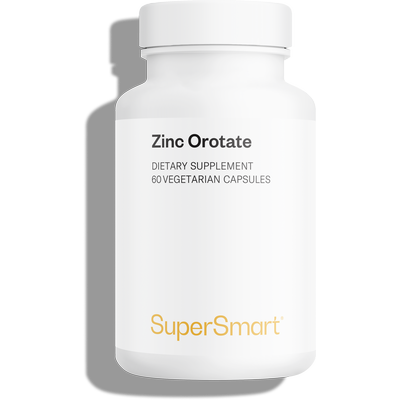
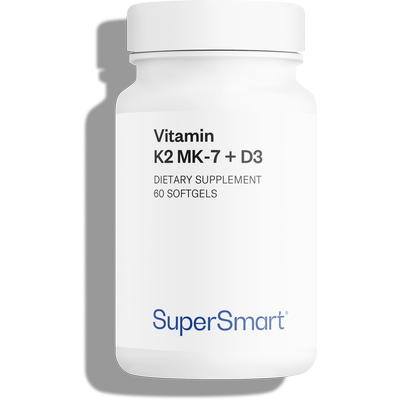
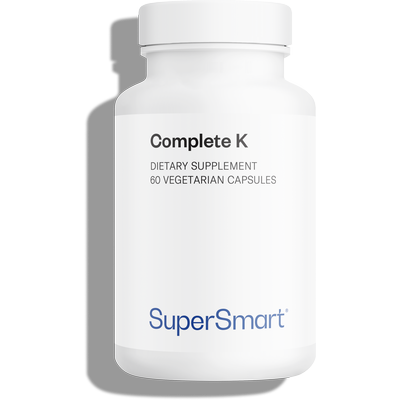
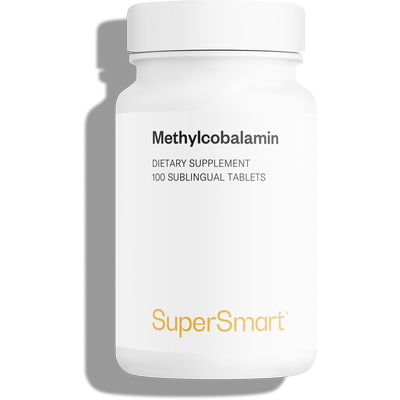
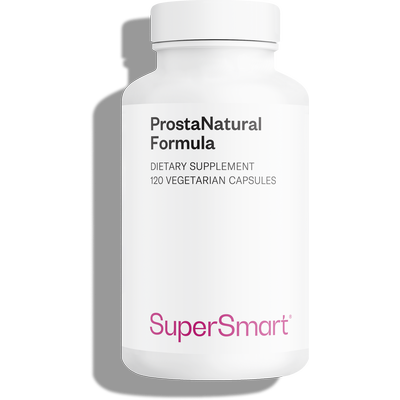
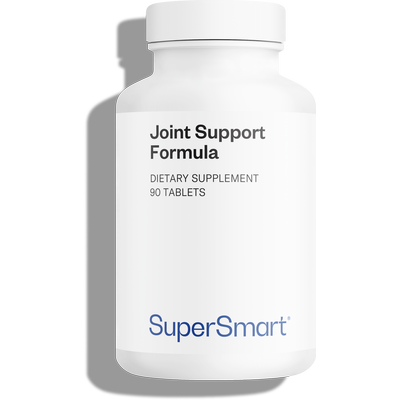
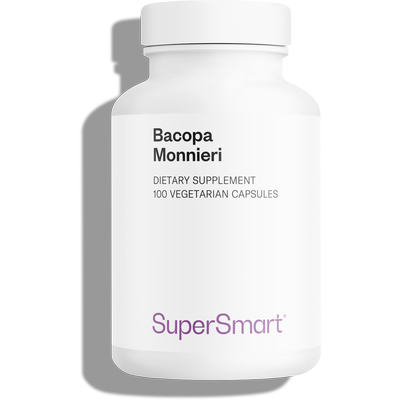
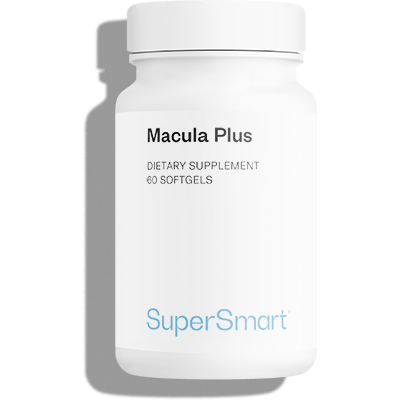
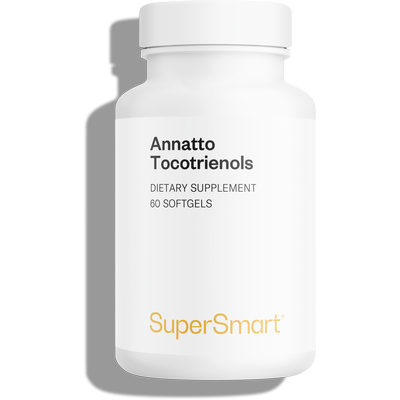
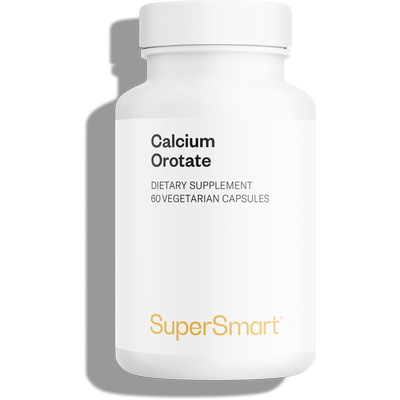
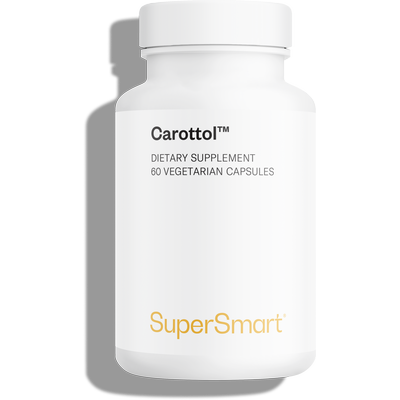
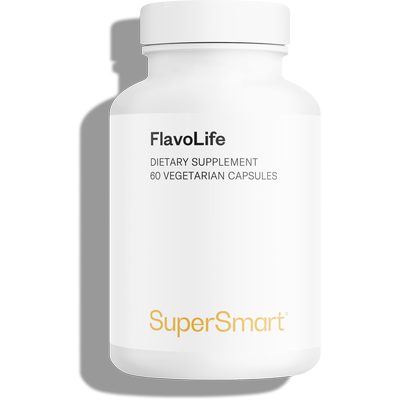
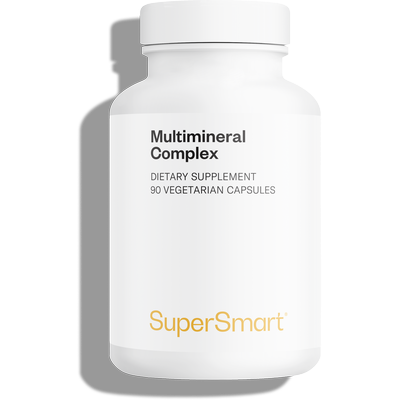



Hallo,
Hartelijk dank voor uw feedback over onze Vitamin D3 5000 UI. De exacte samenstelling van onze producten, inclusief de excipiënten, is beschikbaar op onze website onder de rubriek "Nutritionele informatie" bij elk product. U kunt ook deze informatie terugvinden op de etiketten van de producten zelf.
Als u verdere vragen heeft, aarzel dan niet om contact met ons op te nemen. We helpen u graag verder.
Vriendelijke groeten,
Gaëlle
Klantenservice Supersmart